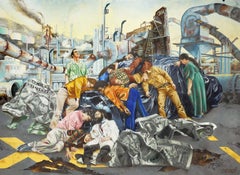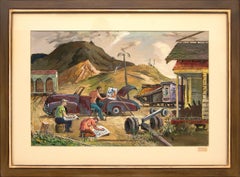Ron Croci Art
to
1
Overall Width
to
Overall Height
to
1
1
1
1
1
1
1
1
1
1
1
1
10,083
2,772
1,380
1,375
1
Artist: Ron Croci
'Any Day in America', Social Realist, Beat Generation, Allen Ginsberg
By Ron Croci
Located in Santa Cruz, CA
'Any Day in America' by Ron Croci.
Social Realist, Beat Generation, Allen Ginsberg
-----
Signed lower right, "Croci" for Ron Croci (American, born 1945), and painted circa 1970.
A ...
Category
1970s American Modern Ron Croci Art
Materials
Watercolor, Handmade Paper
Related Items
Summer Afternoon Stroll Watercolor Lower Eastside - Urban Modernist 1936 Signed
By Bernard Von Eichman
Located in Soquel, CA
Summer Afternoon Stroll Watercolor Lower Eastside - Urban Modernist 1936 Signed
Stunning New York City urban modernist watercolor titled "Summer Afternoon Stroll" by Society of Six...
Category
1930s American Modern Ron Croci Art
Materials
Archival Paper, Watercolor
$6,076 Sale Price
20% Off
H 28 in W 22 in D 0.25 in
Artists Sketching, California, 1940s Large Modernist Gouache Painting, Landscape
By Frederick Shane
Located in Denver, CO
This original 1940s American Modernist gouache on archival paper painting, "Artists Sketching (California)," captures a dynamic scene of three artists at work against a majestic mountain backdrop. With expressive brushwork and a rich color palette, the piece embodies Frederick E. Shane’s signature blend of realism and modernist abstraction. Signed, titled, and dated by the artist in the lower margin, this remarkable artwork reflects the era’s Regionalist influence and the artist’s keen eye for capturing creative moments in the natural landscape.
The painting is professionally housed in a custom archival frame, ensuring long-term preservation. Frame dimensions: 25.5 x 37.5 x 1.5 inches. Image size: 20.25 x 29.75 inches.
Provenance: Estate of the Artist, Frederick Shane
About the Artist: Frederick E. Shane (1906-1992)
A celebrated Missouri Regionalist painter and printmaker, Frederick E. Shane was known for his compelling genre scenes, landscapes, seascapes, and portraits in a variety of media, including oil, watercolor, gouache, tempera, and lithography. While fundamentally a realist, Shane often incorporated elements of abstraction, expressionism, and surrealism, adding depth and emotion to his compositions.
During the summers of 1925-26, Shane studied under Randall Davey at the Broadmoor Academy in Colorado Springs, an institution founded in 1919 by philanthropists Spencer and Julie Penrose. Shane remained closely connected to the Colorado Springs Fine Arts Center, the Academy’s successor, throughout the 1940s and early 1950s, participating in Artists West of the Mississippi exhibitions and forming lasting friendships with key figures like Boardman Robinson and Adolph Dehn...
Category
1940s American Modern Ron Croci Art
Materials
Gouache
$3,000 Sale Price
61% Off
H 25.5 in W 37.5 in D 1.5 in
Till the Clouds Roll By 1945 Frank Sinatra Mid Century Modern Hollywood Film WPA
By Richard Whorf
Located in New York, NY
Till the Clouds Roll By 1945 Frank Sinatra Mid Century Modern Hollywood Film WPA
TILL THE COULDS ROLL BY (Film Set), oil on canvas, 20 x 24 inches signed “Richard Whorf” lower right and signed and dated on the verso “R. Whorf/ Dec. 21, 1945. Frame by Hendenryk.
ABOUT THE PAINTING
This painting is from the collection of Barbara and Frank Sinatra, dated December 21, 1945 (just nine days after Frank Sinatra’s 30th birthday), and depicts the Metro-Goldwyn-Mayer Culver City backlot during the filming of Till the Clouds Roll By, the direction of the film having been taking over by Richard Whorf in December 1945. It is not presently clear if Whorf gave the Sinatras this painting as a gift, as the presence of the Dalzell Hatfield Galleries label on the verso indicates the painting may have been sourced there. Frank and Nancy Sinatra acquired a number of works from Dalzell Hatfield Galleries during the 1940’s, or perhaps they framed it for the couple.
Sinatra performed “Old Man River’ in the film. Sinatra and June Allyson are depicted in the center of the painting.
PROVENANCE From the Estate of Mrs. Nancy Sinatra; Dalzell Hatfield Galleries, Ambassador Hotel, Los Angeles.
An image of the Dalzell Hatfield label and the back of the original frame (which we replaced with a stunning Heydenrk frame) are attached.
Nancy Sinatra was Fran's first wife. Nancy Rose Barbato was 17 years old when she met Frank Sinatra, an 18-year-old singer from Hoboken, on the Jersey Shore in the summer of 1934. They married in 1939 at Our Lady of Sorrows Church in Jersey City where Frank gave Nancy a recording of a song dedicated to her titled "Our Love" as a wedding present. The young newlyweds lived and worked in New Jersey, where Frank worked as an unknown singing waiter and master of ceremonies at the Rustic Cabin while Nancy worked as a secretary at the American Type Founders.
His musical career took off after singing with big band leaders Harry James and Tommy Dorsey...
Category
1940s American Modern Ron Croci Art
Materials
Canvas, Oil
$75,000
H 31 in W 27 in D 2 in
Stylish Hawaiian Luau Oil Painting by Listed artist Mario Larrinaga (1895-1979)
Located in Baltimore, MD
Mario Larrinaga was born in Baja California in 1895 and moved with his brother to Los Angeles in 1909. He had no formal training in art, but had natural talent that was noticed by local movie studios. He was hired by Universal Studios as a designer, art director and creator of background scenes. He produced some of the background effects for King Kong in 1933. After a career in set design and illustration he focused on painting for pleasure in California, Mexico and Hawaii. He belonged to local art clubs and exhibited his works often.
This stylized modernist work was likely created around 1960. It is oil on wood panel and of a horizontal format, 18” x 36”. It portrays a procession of seemingly Hawaiian natives...
Category
Mid-20th Century American Modern Ron Croci Art
Materials
Oil
$1,650
H 18 in W 36 in D 2 in
1940s WPA Watercolor by Charles Ragland Bunnell, Golden Cycle Mill, Colorado
By Charles Ragland Bunnell
Located in Denver, CO
This original 1940s grayscale watercolor by Charles Ragland Bunnell depicts a semi-abstracted view of the Golden Cycle Mill in Colorado Springs, Colorado. Rendered in subtle gradations of black and gray, the composition reflects the influence of WPA-era Modernism, combining industrial subject matter with expressive abstraction. The work is a notable example of mid-20th-century American Regionalism, capturing both a sense of place and a forward-looking artistic vision.
Bunnell’s restrained palette and simplified architectural forms transform the industrial landscape into a dynamic modern composition, emphasizing structure, rhythm, and atmosphere. The subject references the Golden Cycle Mining and Reduction Company, a major contributor to Colorado’s early 20th-century mining industry, located in what is now Old Colorado City. Through this modernist lens, the painting documents an important chapter of Western industrial history.
The watercolor measures 8 1/8 x 9 5/8 inches (sight size) and is presented in a custom black frame measuring 18 x 19 ½ x 1 ⅜ inches, making it a refined, display-ready piece for collectors of American Modern art, WPA works, and industrial landscapes.
Charles Ragland Bunnell (1897–1968) was a pioneering Colorado modernist, New Deal art...
Category
1940s American Modern Ron Croci Art
Materials
Watercolor
$1,268 Sale Price
57% Off
H 18 in W 19.5 in D 1.5 in
A Sunny 1948 Modern Lake Michigan Beach Scene by Chicago Artist, Harold Haydon
By Harold Haydon
Located in Chicago, IL
A charming, colorful 1948 Mid-Century Modern beach scene by notable Chicago artist, Harold Haydon. Depicting a sunlit beach scene with bathers and sailboats painted along the sandy ...
Category
1940s American Modern Ron Croci Art
Materials
Paper, Oil
$850
H 16 in W 21 in D 1 in
"6th Avenue El" American Scene Social Realism Mid-20th Century New York City
By Ernest Fiene
Located in New York, NY
"6th Avenue El" American Scene Social Realism Mid-20th Century New York City
Ernest Fiene (1894-1965)
"6th Avenue El"
12 1/4 x 14 1/4
Oil on canvas board, c. 1940s
Signed lower righ...
Category
1940s American Modern Ron Croci Art
Materials
Oil, Board
“Central Park in Winter, 1949” Manhattan New York City Snow Day Sleds Children
Located in Yardley, PA
With a studied hand, Sloan captures the human theater of a snow-covered Central Park filled with bundled-up New Yorkers, sledding, walking, chatting, and caring for children. The exp...
Category
1940s American Modern Ron Croci Art
Materials
Tempera, Oil, Masonite
$5,500
H 29.75 in W 35.75 in D 2 in
"History of US Postal Service" American Scene Social Realism WPA Modern Chicago
By Harold Haydon
Located in New York, NY
"History of US Postal Service" American Scene Social Realism WPA Modern Chicago
Harold Haydon
"History of the U.S. Postal Service"
21 x 25 1/2 inches
O...
Category
1930s American Modern Ron Croci Art
Materials
Canvas, Oil
"Drama Teacher" 1938 WPA Mid 20th Century American Theatre Surrealism Modernism
By Leon Bibel
Located in New York, NY
"Drama Teacher" 1938 WPA Mid 20th Century American Theatre Surrealism Modernism. 30 x 24 inches. Oil on Canvas. Signed land dated ’38 lower left.
The photograph in the listing depicts the artist's friend who taught drama and about whom the painting is based
Painter, printmaker and sculptor, Leon Bibel was born in San Francisco in 1913. He trained at the California School of Fine Arts and received a scholarship to study under the German Impressionist Maria Riedelstein. He worked in collaboration with Bernard Zackheim, a student of Diego Rivera, to create frescoes for the San Francisco Jewish Community Center and the University of California Medical School.
In 1936 Bibel moved from California to join the Federal Art Project at Harlem Art...
Category
1930s American Modern Ron Croci Art
Materials
Canvas, Oil
"War Brides, Wash Sq NYC" American Scene WWII Modernism WPA Mid-Century Oil
By Georgina Klitgaard
Located in New York, NY
"War Brides, Wash Sq NYC" American Scene WWII Modernism WPA Mid-Century Oil. 30 x 40 inches. Oil on canvas, c. 1942. Signed lower right. Titled on the stretcher. Housed in a sensational Heydenryk frame.
Our gallery, Helicline Fine Art...
Category
1940s American Modern Ron Croci Art
Materials
Canvas, Oil
$8,500
H 38 in W 48 in D 2 in
Summer Resort in Michigan -Modernist Mid-Century Saugatuck Oil Painting
Located in Marco Island, FL
Summer Resort in Michigan is an exceptional work painted by the Chicago Modernist, William Schwartz. He studied at the Art Institute of Chicago shortly ...
Category
1940s American Modern Ron Croci Art
Materials
Canvas, Oil
$68,000
H 51 in W 33 in D 2 in
Ron Croci art for sale on 1stDibs.
Find a wide variety of authentic Ron Croci art available for sale on 1stDibs. You can also browse by medium to find art by Ron Croci in handmade paper, paint, paper and more. Not every interior allows for large Ron Croci art, so small editions measuring 31 inches across are available. Customers who are interested in this artist might also find the work of Tom Perkinson, Scott Duce, and Gregory Steele. Ron Croci art prices can differ depending upon medium, time period and other attributes. On 1stDibs, the price for these items starts at $5,500 and tops out at $5,500, while the average work can sell for $5,500.


